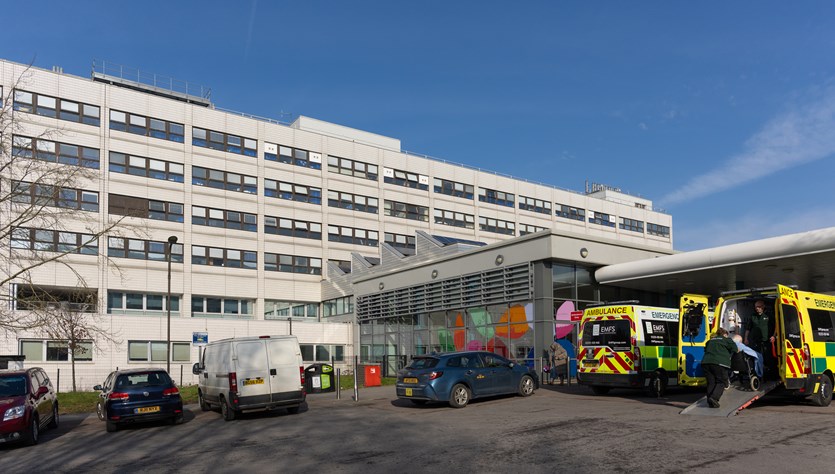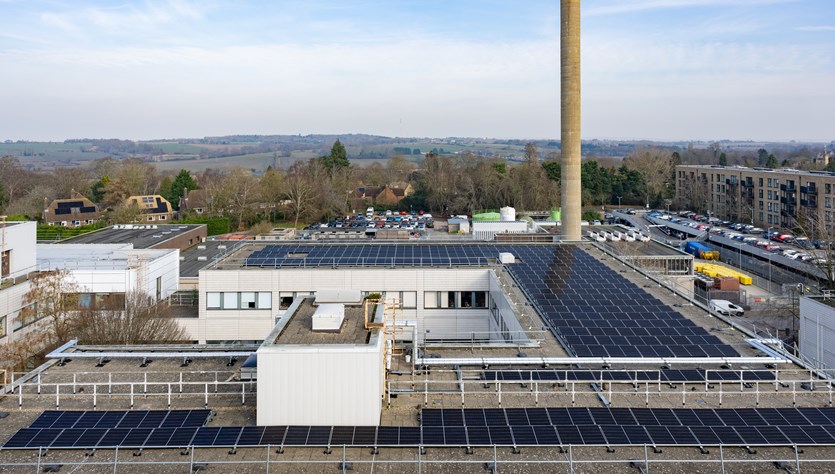The £38m Oxford University Hospitals (OUH) project represents one of the UK's most ambitious healthcare decarbonisation programmes, transforming energy infrastructure across two hospital sites, the John Radcliffe and the Horton, whilst maintaining uninterrupted clinical services.


An infrastructure refresh addressing failing steam systems evolved into a transformational decarbonisation programme following our successful PSDS applications securing £24.1m for John Radcliffe hospital in Oxford and £5.7m for Horton General Hospital in Banbury, with OUH contributing £8.2m.
We delivered a complete system transformation from steam to low-temperature hot water, installing heat pump technology, solar PV, and advanced building management systems throughout the three-year programme.
Our solution eliminated obsolete steam infrastructure dating back to the 1970s, replacing it with state-of-the-art low-temperature hot water systems. This complex de-steaming programme required systematic network replacement whilst maintaining operational heating and domestic hot water services to the hospital estate.
We installed cascading air-to-water source heat pumps alongside energy conservation measures including solar PV installation, EC fan replacements, and complete building management system upgrades, eliminating decades of backlog maintenance whilst delivering guaranteed savings.
We pioneered digital twin technology to create virtual replicas of complex hospital energy systems, enabling design modification testing and system issue identification before on-site implementation, dramatically reducing risks and optimising performance.
This technology proved invaluable for mapping heating and chilled water systems across sites creating essential documentation whilst enabling precise system optimisation.
At both sites, the digital twin technology showed that the existing secondary side LTHW heating distribution systems required improvement works to ensure the efficient operation of the new low carbon heat pumps. Hydronic improvement measures that were implemented as part of this project included converting inefficient constant flow heating systems to variable flow systems by installing new speed-controlled pumps, 2-Port valves and removing any low loss headers or unnecessary bypasses in the system.
Our success stemmed from developing an exceptional collaborative partnership with OUH's estates team, characterised by trust, flexibility, and shared problem-solving. The estates team's professional approach enabled us to navigate complex challenges whilst maintaining the high standards required for critical healthcare infrastructure.
Through regular coordination meetings, detailed look-ahead planning sessions, and integrated project management approaches we were able to keep all stakeholders fully informed and aligned. This partnership proved particularly valuable given the need to accelerate the project design, necessitated by the rapid PSDS application turnaround.
Our commitment to utilising incumbent supply chain familiar to the Trust created additional comfort for the client whilst supporting local businesses. This approach proved mutually beneficial - our teams gained local knowledge whilst the Trust worked with known quantities, reducing project risks and enhancing stakeholder confidence.
Our multi-layered funding approach transformed financially unviable decarbonisation into a commercially attractive proposition. Phase one utilised third-party funding delivering immediate operational savings and demonstrating project viability.
For phase two we leveraged PSDS grant funding to help secure £29.8m for the Trust, critical because comprehensive de-steaming would not have been cost-effective through either Trust capital or third-party funding. Our expertise in the rapid turnaround of PSDS applications maximised public sector investment whilst ensuring there would be no increase to the Trust’s annual operating costs.
Transforming the infrastructure across live hospital sites required detailed scheduling around theatre operations, intensive care requirements, and clinical services, with critical works often scheduled between midnight and 5am. The project encompassed two distinct hospital sites with unique operational requirements, as both John Radcliffe and Horton are busy accident and emergency sites, and the John Radcliffe provides acute medical and surgical services that include trauma, intensive care and cardiothoracic services.
The OUH project team included an experienced and well-respected clinician who, in the planning stages was able to point out potential hurdles so they could be resolved early. And in the implementation phases talked peer-to-peer with ward staff to iron out any issues that did arise. This clinical/ops liaison ensured that the work had as little impact on patient care as possible, reduced delays and built a good working relationship between the project team and clinicians.
Our approach included comprehensive resilience measures such as temporary steam-to-low-temperature hot water plate heat exchangers and standby boiler systems, ensuring service continuity during the transition. We successfully managed the complex transition from multiple system types—steam, medium-temperature hot water, and low-temperature hot water—to unified low-temperature hot water systems, dramatically simplifying operations which improves efficiency and reliability whilst addressing significant backlog maintenance issues. The new system provides enhanced resilience through dual fuel boilers which provide top-up and back up heat to the heat pump systems.
We operate under a comprehensive Energy Performance Contract providing absolute certainty over performance and costs. While the project's primary driver was decarbonisation through the Public Sector Decarbonisation Scheme, we ensured cost neutrality through strategic energy conservation measures including solar PV installation, BMS upgrades, and high-efficiency EC fans.
Guaranteed annual savings cover energy and service cost reductions. The 25-year contract delivers budget certainty whilst guaranteeing over 3,500 tonnes CO2 savings annually. Vital Energi assumes full operational risk, ensuring the Trust benefits from cutting-edge technology without operational uncertainties, replacing end-of-life assets that were costing significant amounts in backlog maintenance.
Social value delivery is increasingly important in public sector procurement, and we take pride in making meaningful contributions to local communities. We engaged local contractors familiar to the Trust, created apprenticeship placements and work experience programmes for young people, and developed a charitable partnership with the on-site Ronald McDonald House.
Our commitment to the Ronald McDonald House extended beyond the traditional corporate partnership. We donated £10,000 to the charity and our team spent a full day volunteering at the house, completing essential maintenance tasks and transforming the garden spaces. This hands-on involvement allowed us to go behind the scenes and assess their energy systems from a technical perspective. "We managed to get a good feel for their energy generation, and have identified how we can make it more energy efficient, saving both money and carbon. It's great to be able to contribute in this way and leave a lasting impact on the House."
These initiatives demonstrate our commitment to developing skilled professionals whilst meeting escalating social value expectations, establishing templates for future healthcare projects that combine technical expertise with genuine community impact.
Our solution established a new benchmark for healthcare energy transformation through innovative technology deployment. The 930kWp solar PV installation, advanced heat pump systems, and sophisticated energy management create a platform for continued decarbonisation as grid electricity becomes increasingly renewable.
We delivered exceptional value through guaranteed savings, complete risk mitigation, and seamless funding access whilst maintaining uninterrupted clinical operations across two complex hospital sites.
The project showcases engineering excellence through innovative renewable technology deployment, digital twin optimisation, and comprehensive de-steaming at one of Europe's largest teaching hospital complexes. Our success provides a proven framework for ambitious NHS decarbonisation programmes, demonstrating that even the most challenging healthcare estates can achieve net-zero objectives whilst enhancing operational resilience and patient care environments.
The project provides a replicable template for large-scale NHS decarbonisation, demonstrating that comprehensive infrastructure transformation can be achieved without compromising patient care whilst delivering substantial environmental and financial benefits through innovative funding structures and collaborative partnership approaches.
"The Public Sector Decarbonisation Scheme has been fundamental to improving the John Radcliffe and Horton hospitals for our patients, staff, and visitors. The modernisation of the building's heating and hot water infrastructure will improve our energy efficiency by adapting a range of low carbon technologies and support our journey towards the national target for a net zero NHS carbon footprint by 2040."
Jeenash Mistry, Head of OUH's Facilities and Estates Operations

